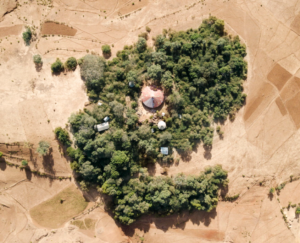You have no items in your cart. Want to get some nice things?
Go shopping
Don’t judge a book by its cover, they say – but of course that’s what we all do, and I readily confess that I was attracted to The Church Forests of Ethiopia for its austere (yet vibrant), as well as self-contained (yet potent) cover design – faithfully reflecting the essence of Ethiopian church forests: neatly enclosed spaces bursting with life. The photographs in The Church Forests of Ethiopia are far from spectacular. They have a subdued quality, both in tone and in their choice of setting. They display restraint rather than abundance, and they offer clues the viewer may choose to follow – or discard. And, far from offering a hundred views from above, Kieran Dodds’ recourse to drone photography is sparse. This came as a surprise (perhaps I should have better studied that book cover – understated, elegant), as Ethiopia is, in many ways, intensely spectacular (but deeply reserved, too). But if Ethiopia is a land of paradoxes, it does offers exoticism in spades, both to the writer and, perhaps especially, to the photographer.
But what is an Ethiopian Church forest, you may well ask? The conservationist Alemayehu Wassie Eshete tells us from the start, in his foreword that, “in the northern highlands of Ethiopia, most forests have been completely destroyed and converted into farms and grazing lands over centuries (…) Afromontane forests do remain (…) mostly found surrounding Orthodox Tewahedo churches.” Alemayehu Wassie Eshete (a good name for a conservationist, Eshete, as it roughly translates into English as my green shoot!), provided guidance to Kieran Dodds so that the photographer could “capture beautifully the contrast of the green church forests with the surrounding bare lands.”
And don’t be put off by the word Afromontane, as it is simply the name for the temperate forests found at high altitudes in Africa – think juniper and rosewood, olive trees and sycamores. These forests grow in an arc, running from Eritrea to Rwanda, but are most prevalent in the Horn of Africa (as Ethiopia possesses 70% of the continent’s highlands). There is much debate about how much of Ethiopia used to be forested, and while many repeat that “41% of the country used to be covered in forest,” recent pollen studies suggest that much of the highlands were converted to grasslands and tilled fields long ago (Dodds tells us that the country has lost 90% of its forest coverage over the last century.) But that forest once covered vastly larger areas than today is an obvious fact (while the country recently carried out a record-breaking tree planting campaign, even the fast growing eucalyptus cannot keep up with Ethiopia’s ever rising needs of timber and fuel – but that’s a different, even if highly related, story.)
I worked a few years ago on a Yann Arthus-Bertrand exhibition held at the Alliance Française in Addis Ababa. Bertrand is world famous for his aerial photography taken all over the world (He gets to use a helicopter.) His photographs are spectacular, highly saturated, full of meaning and very, very beautiful. Viewers know what they are looking at, as is it self-evident. For the Addis exhibition, Arthus-Bertrand added to his world pictures (the Okavango Delta, polychromous shantytowns in Brazil) a special series on the Timkat ceremonies held in Gondar. And I can’t say I didn’t like them (Everybody did; they really were spectacular.) But I also know that such pictures could no doubt be taken by a drone without a human operator, given the right program (Perhaps this is recognised by Yann Arthus-Bertrand himself as he recently pledged…to no longer fly – although I think he claimed he was doing his part to fight global warming.)
I recognise Kieran Dodds’ pictures of Ethiopian Church forests – for that’s exactly what they look and feel like. And when Dodds portrays Ethiopians, he captures them with great simplicity, too. And I find that, again, that really is what Ethiopians look like – these could very nearly be “candid” shots, fired from the hip. Ethiopians have striking features (to Western viewers) – they are, obviously, exotic, and that makes for spectacular photography (Think of Hans Silvester’s famous painted ingénues down in the Omo Valley – curiously, no one seems to mind that the Eden portrayed by the photographer is staged.) Again, I will not pretend to not be taken by this; novelty and shock, strange beauty or weird traits – they are of immediate appeal to us all.
There is nothing intrinsically wrong with this (or, if so, it is human nature that is flawed), but we should still strive to find the commonalities that connect us, rather than build frames for our differences (Ethiopia, too, readily offers itself to United Colors of Benetton–style cultural collages in which high cheek bones and antiquated Christian paraphernalia become the brand.) In Europe, sacred groves became church grounds, too, and graveyard yew trees were worshipped by pagans before being brought into the fold. Likewise in Ethiopia, where hallowed trees or groves, called adbars, are used to this day in spirit worship. There was one such grove near the stables I used to run in Ethiopia, to the west of Addis Ababa, a picturesque thicket of endemic hardwoods that stood out in the surrounding farmlands full of wheat, peas, and the occasional stand of eucalyptus. The trees were festooned in minute “prayer flags,”while the trunks of the bigger trees were doused in butter and bullocks are still sacrificed every year. The reverence for trees and forests is not limited to a faith or region in Ethiopia – indeed, most of the remaining forests of Ethiopia are located in the southwest, far from the Orthodox Amhara highlands, and the state flag of Oromia bears a large ficus in its centre. And this importance granted to trees is long-standing: In the 15th century, the emperor Zera Yacob declared himself to be preoccupied with the diminution of the forests of his realm and is said in his royal chronicle to have transported seedlings from the crags of Wof Washa, near Ankober, to replenish the woods of Menagesha (in the vicinity of the capital city).
I greatly enjoyed the Geez fidel, the symbols used to write Amharic, Tigrinya, and a number of other Ethiopian languages, parsimoniously used, and to striking effect, throughout the book. One small quibble is that the cover I so like, with its artwork of circled fidels, does not translate the English title but rather conveys the meaning of an “enclosure” comprising the church building, the forest itself, and the palisade or wall that secludes it from the surroundings (although, to be fair, it is nowhere stated that it is a translation.) Another minor quibble is that church forests are not, as explained in the book, the only remaining forests in the Amhara region – Emperor Zera Yacob’s Wof Washa still very much exists today (and when I launched a horse trek, I chose this exact route linking the two forests and called it the Zera Yacob Trail). And there are other forests in the Amhara region, in Wollo, in the Semien Mountains. I liked the map of church forests strewn all over the Amhara region, like a green polka dot motif. I liked less the map of the Great Green Wall of Africa and the suggestion that if it were tweaked to run through Ethiopia, Church forests would somehow benefit…(Recent reports claim that 15% of this “line of trees,” from the Atlantic to the Red Sea, is now complete, but somehow I doubt this to be true. It reminds me of a scheme I once participated in as an interpreter to encourage Ethiopian farmers to trade carbon on their individual trees. Some things are best left outside of bureaucracy.)
Which is not to say that these questions are not vitally important. More than a century ago, Ethiopia’s capital was on the verge of being moved, for lack of fuel and construction timber. The country counted perhaps 10 million inhabitants at the time. Today, there are 110 million Ethiopians, and many of them need wood to cook, to build houses, and to craft their ploughs (Dodds’ picture of a very young, very tall, man carrying a plough, or better said, an ard, on his shoulder is a perfect reminder of this). Back then, the fast growing eucalyptus (or bahar zaf, the “ocean tree” or tree from beyond the seas), saved the day – and preserved the indigenous species from total eradication. But will there be another tree from beyond the oceans to swoop in to the rescue? Then there is the question of beauty and of the spirit, of the sacred and of the profane (and besides, to stick to the material, you can’t make a serviceable plough out of eucalyptus). While Dodds doesn’t offer solutions to these predicaments, he convincingly conveys the importance and the beauty of these church forests. And he does so without over-aesthetising his subject nor running wild with those drone shots. This is a book you can judge by its cover.
About Yves-Marie Stranger
Yves-Marie Stranger Yves-Marie is the author of A Gallop in Ethiopia (also available in French as Un Galop en Éthiopie), and of Ethiopia through writers’ eyes. After living in Ethiopia for fifteen years, he is now based once more in France. You can listen to the podcast of his book The Abyssinian Syllabary on Apple Podcasts and Spotify.
- Web |
- More Posts(3)




